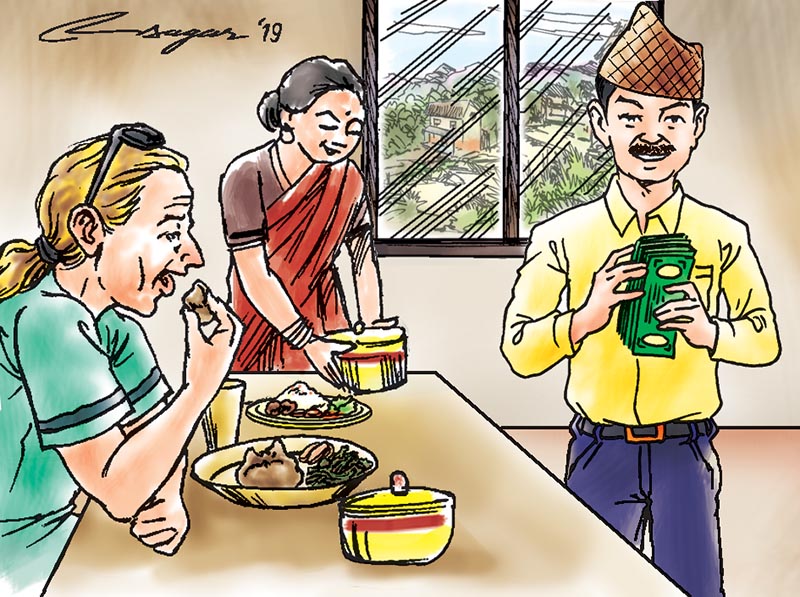Homestay tourism: A home away from home
Homestay is still taken as a passive business for the uneducated, unemployed and dependent members of a family. If this trend continues, then homestay tourism can collapse within the next generation
The spirit of Nepali tourism lies in the natural richness and its indigenous societies with their mystic cultures which can be best showcased through the homestay programme. Apart from the thousands of hotels and resorts catering to the tourists, the charm of homestay is also mounting.
Homestay, still an afterthought dimension of tourism in Nepal, is gradually becoming a dominant hospitality market. The main reason for its growth is it adds genuine socio-cultural components to a tourist’s experience. For many travel enthusiasts, homestay provides just the opportunity to assimilate with the local customs, relish the local cuisine and get to know the real local lifestyle. It is one among the inimitable chances to experience life as it is lived.
As British photographer Martin Parr once said, “The thing about tourism is that the reality of a place is quite different from the mythology of it.” Nepal’s diverse population with an equally unique traditional and cultural way of life can best be explored through homestay tourism. It would further revive local cultures by showcasing real Nepal to the rest of the world.
Nepal can transform the inherent blessings of nature into tourism potentiality in the rural areas via homestay. Considering that the country lacks extensive infrastructural investment but possesses rich assets to attract tourists in the remote communities, homestays can function as an alternative ground. It’s a rare type of lodging practice that has evolved under tourism to contribute to the development of sustainable tourism practice in Nepal. Likewise it also thrives as a progeny of eco-tourism and village tourism, which aim to solidify the local economy by consuming local resources and encouraging local entrepreneurship. This type of tourism practice usually stands on three bases, which include attraction, service and promotion. Till date Nepal holds strong in attraction only whereas it lacks investment in the other two domains.
This particular hospitality industry must expand its offerings to move on. While upgrading homestay services, the stakeholders should strive to blend the domestic lifestyle with basic international standards, that is, offering the local experience in modern ways for international tourists. This would add more welcome doors at many virgin tourist destinations.
Homestays empower natives to become micro-entrepreneurs by capitalising on their way of life and space that already exist at home. It further monetise women’s household chores which otherwise would never have got any economic value and make women financially independent.
Concerning market feasibility of the community homestay programme in Nepal there seems more opportunities than threats. It just requires proper advertisement and institutional arrangements. As the pristine land is situated between the two giant populations of India and China, this geographical framework will automatically upturn the tourism scope. The Himalayan country needs no artificial polish to paint its natural attractions, it just requires a creative approach and huge promotion to develop the tourism product.
At present, the practical threat to homestay tourism is its sustainability. Taking the case of some successful community homestay models, such as Ghale Gaun and Sirubari, these homestay programmes have been facing the generation doom. Most of the homestays are operated by old, uneducated and women’s groups while the young generation has migrated to the cities or foreign lands in search of greater opportunities. Particularly in Sirubari, the elderly people are engaged in homestay tourism activities.
Homestay is still taken as a passive business for the uneducated, unemployed and dependent members of a family. If this trend continues, then homestay tourism can collapse within the next generation. Likewise unprofessional tourism management and absence of government initiatives in research and planning of homestay tourism further put its sustainability on the vulnerable edge. Issues of poor groundwork, such as roads, health facilities in rural tourist places and research and plans are often overlooked. Also the government has not exercised proper caution to protect indigenous cultures and heritage, the backbone of homestay tourism in Nepal.
Similarly in the management of community homestay practice, the issue of benefit sharing among the community members remains a problem. Therefore, a collective distribution system should be planned in such a way that every stakeholder involved in this sector gets his or her share. Also establishing a community fund to invest in infrastructure and service can further improve this sector. There is urgent need for digital promotion and creation of genuine homestay tourism database so that visitors can easily explore, choose the package and book their stay. Administrations like the Nepal Tourism Board and Village Tourism Promotion Forum Nepal should take initiatives.
Despite some challenges, homestay programmes are growing. Namely Kavrepalanchok has registered more than 26 such homes while Makwanpur has at least 11 and Chitwan and Nuwakot have around 10 and 12 respectively. Gorkha, Ilam, Palpa, Syangja, Kailali and Chitlang too are on the bandwagon. The particular initiative will serve the government’s sustainable tourism development policies by building the capacity in the rural community.






